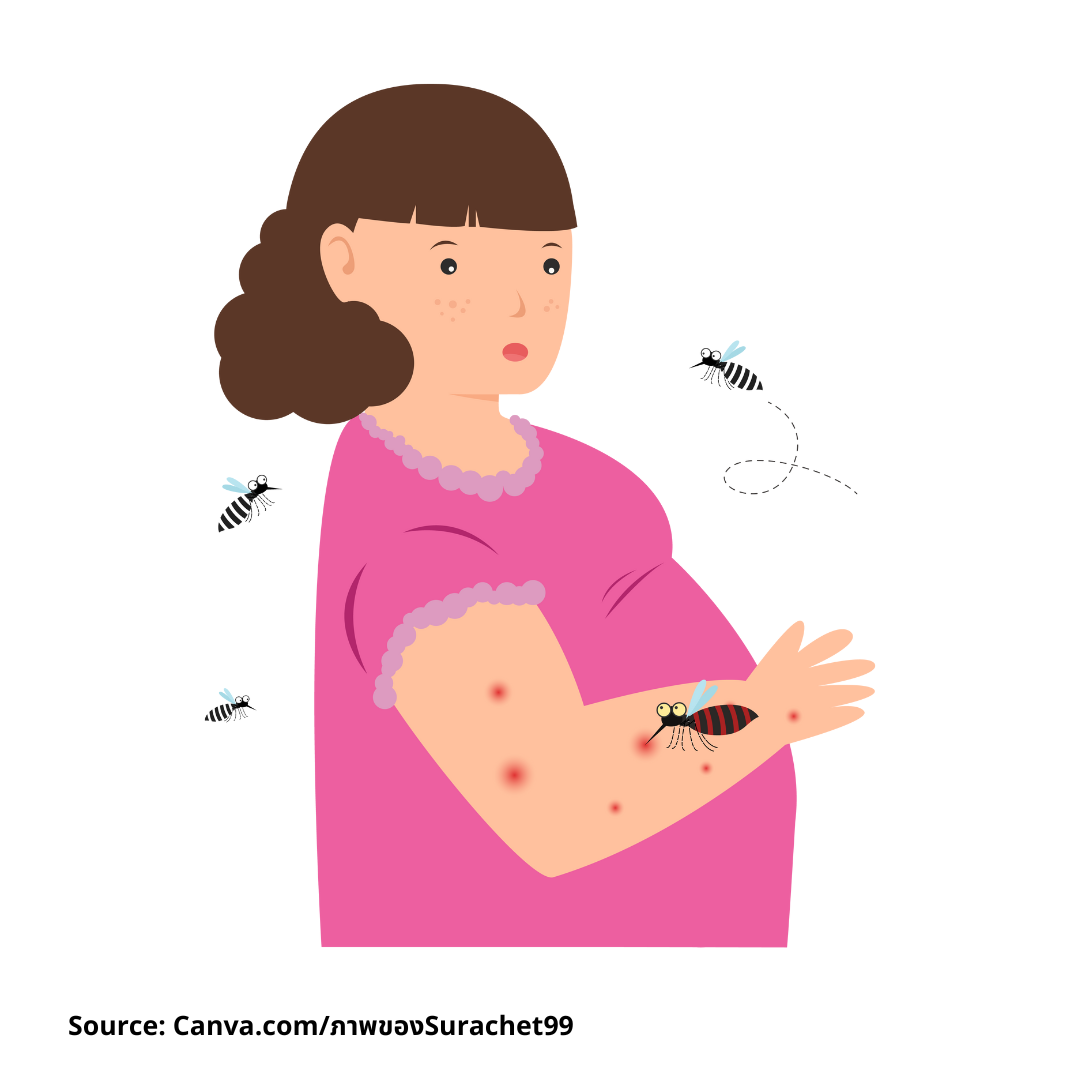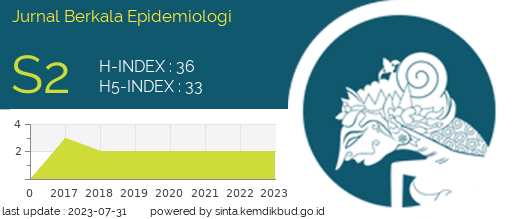ANALYSIS OF RISK FACTORS FOR PREGNANT WOMEN INFECTED WITH MALARIA
Analisis Faktor Resiko Ibu Hamil Yang Terinfeksi Malaria

Background: Malaria is a disease caused by protozoa infection of the genus Plasmodium transmitted through the bite of infected female Anopheles mosquitos. Malaria infection in pregnancy is detrimental to both the mother and the fetus. Several efforts to prevent and eradicate malaria have been implemented, but many pregnant women are still infected with malaria. Purpose: To know the risk factors for pregnant women infected with malaria. Methods: This study used the literature review method by searching for articles analyzing risk factors for pregnant women infected with malaria. Articles were searched from two databases, namely PubMed and Google Scholar. The keywords used are "Pregnant Women" AND "Infected Malaria". The inclusion criteria (IC) in the article search were publication year: articles published in the last 5 years from 2018-2023 with the subject of pregnant women infected with malaria; the paper should be full text, with a Cross-sectional and case-control study. Results: This study involves 10 articles discussing the analysis of risk factors for pregnant women infected with malaria. Some studies revealed that the host, agent, and environment highly determine the spread of malaria. The spread of malaria occurs when those three components support each other. Risk factors for malaria are pregnant women's residence, wire netting installation on ventilation, and use of mosquito nets and repellent. Conclusion: Based on the reviewed articles, it can be concluded that pregnant women who do not use mosquito nets and whose residences are close to standing water and bushes have a greater risk of getting malaria.
INTRODUCTION
Malaria is the central public health problem in tropical and subtropical countries (1). This disease still becomes a threat to society due to its high morbidity and mortality rates at reproductive age (2). Malaria is caused by protozoa infection of the genus Plasmodium transmitted through the bite of infected female Anopheles mosquitos. This disease attacks organs such as the brain, liver, and kidneys, and then parasites grow and reproduce in these organs (3). Its transmission is the same as other infectious diseases in general, namely determined by the host (humans and Anopheles mosquitoes), agent (plasmodium parasites), and environment (physical, chemical, biological, and social environment) (4,5).
Malaria is one of the most common infectious diseases found in various countries. Globally, there were 82.6 million babies born to pregnant women who are at risk of infection with Plasmodium (P) falciparum and P. vivax, which cause malaria. The incidence of malaria P. falciparum and P. vivax reaches 88.2 million (70%) out of the total 125,200,000 pregnancies (6). Of these, 54.4 million occurred in malaria-endemic areas in the Asia-Pacific region and 33 countries with moderate and high transmission in the African Region in 2020. The World Health Organization (WHO) estimated that 11.6 million (34%) out of 33,8 million pregnancies were exposed to malaria infection during pregnancy(7). Most cases of malaria were found in the African region (93%), followed by the Southeast Asian region (3.40%) and the Eastern Mediterranean region (2.10%) (8). In Indonesia, malaria cases reached 235,700 cases in 2020. The Ministry of Health reported 304,607 malaria cases in 2021(9). In pregnancy, malaria becomes a significant cause of morbidity and mortality, causing approximately 100,000 neonatal deaths and 10,000 maternal deaths each year(10).
Malaria is an infectious disease whose control efforts are a commitment to the Sustainable Development Goals (SDGs) until 2030(11). Malaria is a public health problem that can cause death, reduce work productivity and affect various aspects of life (11). Symptoms appear 10 to 15 days after being bitten by an Anopheles mosquito in the form of intermittent mild fever, headaches, muscle aches, chills, and feeling unwell (malaise) (12). This disease can affect all individuals regardless of age, gender, and pregnant women (3). Malaria infection in pregnancy is detrimental to both the mother and the fetus because it can increase the incidence of morbidity and mortality (13). In mothers, malaria infection can cause anemia, pulmonary oedema, cerebral malaria, kidney failure, and even death. In the fetus, it can cause premature labour, abortion, LBW, and death(14).
Pregnant women are more susceptible to parasite infection, and this susceptibility is most closely related to the immunological changes during pregnancy. The parasites causing malaria tend to accumulate in the placenta (15). Plasmodium causes malaria and hurts pregnancy and babies(16). Malaria infection in pregnancy is detrimental for both the mother and the fetus as it can increase the morbidity and mortality of both mother and fetus(17). In pregnant women, malaria can cause fever, anemia, hypoglycemia, acute pulmonary oedema, kidney failure, increased risk of premature birth, trigger an abortion, low birth weight (LBW), fetal weight less than gestational age (IUGR), and even death (18). Pregnant women can quickly contract malaria due to immune system changes during pregnancy, including cellular and humoral immunity, and an increase in cortisol hormone. This infection can worsen pregnancy, leading to severe anemia. The parasite can also affect blood supply to the placenta, causing it to invade and disrupt the transplacental transfer of food and oxygen, potentially causing pre-term birth.(19). Without proper and immediate handling, it will continue in the delivery process, which can also cause post-partum bleeding (20). This study aims to analyze the risk factors for pregnant women infected with malaria.
METHODS
This study used the literature review method by searching articles from specific databases. This study used secondary data obtained from the results of previous studies and not through direct observation. The inclusion criteria (IC) consist of IC1 article should be published in the journal, IC2 in the article search were publication year, namely articles published in the last 5 years from 2018-2023 with the subject of pregnant women infected with malaria, IC3 with Cross-sectional study and case-control, IC4the paper should be full text.
The article search used keywords (NOT, OR AND or AND NOT) to make searching for the required journal easier. The keywords used are "Pregnant Women" AND "Infected Malaria". Secondary data sources are articles related to the topic obtained from Google Scholar and PubMed. In IC1, published journals obtained 4,650 articles; in IC2, the researcher determined the publication year from 2018 to 2023, obtaining 4,600 articles. In IC3, the selection criteria were using the same type of method, while IC4 selected excluded journals due to duplicates and unsuitable article contents with the issue in this study. After selecting the articles according to the topic of this study, the researcher obtained 420 journals.
Further identification was carried out in more detail to determine relevant articles that meet the inclusion criteria in this literature review. Based on IC1-IC4 selection criteria, some articles were selected for further review. Then, they were reselectedbased on IC5, namely based on the compatibility of article titles and abstracts with the aim of this review literature, namely to have the main content related to risk factors in pregnant women infected with malaria. Finally, the researcher obtained 10 articles for further review. The process of identifying articles can be seen in Figure 1.
Figure 1.PRISMA Diagram
WHO. WHO | Malaria in pregnant women. WHO. 2018.
Manik IRU, Rumansara R, . R. Risk factors for malaria incidence in pregnant women in Puskemas Bosnik and Marau regency Biak Numfor. J Kebidanan Kestra. 2022;4(2):120–7.
Ilyas H, Serly S. Overview of malaria cases in pregnant women at the Boven Digoel District General Hospital, Papua. An Idea Heal J. 2021;1(1).
Safitri V, Amal F, Wijayanti I. Factors related to the event of malaria in pregnant women in Harapan Health Center. JOMISBAR J Midwifery Sci. 2021;3(1).
Rokhayati DA, Putri RC, Said NA, Rejeki DSS. Analysis of malaria risk factors in Southeast Asia. Balaba J Litbang Pengendali Penyakit Bersumber Binatang Banjarnegara. 2022;18(1):79–86.
Wahyuni S, Yogi R, Suci ES, Sihotang FF, Simanjuntak R. Continuity of care assistance related to malaria and anemia by activating the health center in Doyo Baru Village, Jayapura Regency. Indones J Community Serv. 2022;4(1):11–21.
WHO. Word Malaria Report 2021. Word Malaria report Geneva: World Health Organization. (2021). Licence: CC BY-NC-SA 3.0 IGO. 2021. 2013–2015 p.
Doe MTT, Bajinka O, Barrow A. Antenatal care positive responses to pregnant women in preventing and controlling malaria in pregnancy: the sub-Saharan African perspective. Vol. 18, World Journal of Pediatrics. 2022.
World Health Organization. World malaria report 2019 [Internet]. WHO Regional Office for Africa. Geneva: World Health Organization; 2019. Available from: https://www.who.int/news-room/fact-sheets/detail/malaria
Suliman MA, Tamomh AG, Younis OY, Magboul AM, Mohammed HY, Hassan IM, et al. Malaria infection and associated risk factors in pregnant women attending antenatal care clinics in Al Jabalian Locality, White Nile state, Sudan. Ann Parasitol. 2021;67(3).
Darmawansyah D, Habibi J, Ramlis R, Wulandari W. Determinants of malaria incidence. J Ilmu Kesehat Masy [Internet]. 2019;8(03):136–42.
Ngai M, Weckman AM, Erice C, McDonald CR, Cahill LS, Sled JG, et al. Malaria in pregnancy and adverse birth outcomes: new mechanisms and therapeutic opportunities. Trends Parasitol. 2020;36(2):127–37.
Budd D. Association of Southeast Asian Nations (ASEAN). In: International Organizations and the Rise of ISIL [Internet]. Taylor & Francis; 2018. p. 58–71.
Aguscik A, Ridwan R. The effect of nutritional status on the incidence of anemia in pregnant women in malaria endemic areas of Bengkulu City. JPP (Jurnal Kesehat Poltekkes Palembang). 2019;14(2):96–9.
Touré AA, Doumbouya A, Diallo A, Loua G, Cissé A, Sidibé S, et al. Malaria-associated factors among pregnant women in Guinea. J Trop Med. 2019;2019.
Purwatiningsih Y, Lestyoningrum SD, Puspita D. Systematic review: prevalence and outcome of malaria infection in pregnant women and neonatal. Balaba J Litbang Pengendali Penyakit Bersumber Binatang Banjarnegara [Internet]. 2022;18(2):119–28.
Mutoharoh S, Rahmadhani, W. Hypnobirthing as an effort to reduce pregnant mother’s anxiety facing the COVID-19 pandemic in 2021. ABDIMAS J Pengabdi Masy. 2021;4(2).
Masengi EMBP, Wantania JJE, Mongan SP. Incidence and outcome of malaria in pregnancy in several hospitals in North Sulawesi. J Med dan Rehabil. 2019;1(3).
Erhabo O, Abdullahi A, Tosan E, Charles AT. Risk factors associated with malaria infection among pregnant women of African Descent in Specialist Hospital Sokoto, Nigeria. Obstet Gynecol Int J. 2019;10(4).
Segala FV, Di Gennaro F, Ictho J, L’Episcopia M, Onapa E, Marotta C, et al. Impact of antimalarial resistance and COVID-19 pandemic on malaria care among pregnant women in Northern Uganda (ERASE): protocol of a prospective observational study. BMC Infect Dis. 2022;22(1).
Nurjana MA, Samarang S, Ningsi N, Octaviani O. Malaria at vulnerable group in Indonesia (Analysis of Riskesdas 2018). J Vektor Penyakit. 2022;16(1):59–68.
Rahmadhani W. The affecting factors of implementation of expanding maternal and neonatal survival program by the Ministry of Health of the Republic of Indonesia in determining midwifery in Kebumen, Central Java, Indonesia. In: Proceedings of the 2nd Borobudur International Symposium on Humanities and Social Sciences, BIS-HSS 2020, 18 November 2020, Magelang, Central Java, Indonesia [Internet]. EAI; 2021.
Handayani EP, Lestari S. Determinants of malaria incidence in pregnant women at Sentani Community Health Center. J Nurs Heal [Internet]. 2023;8(1):111–21.
Jain K, Gupta P, Balodhi A, Deeba F, Salam N. Prevalence of pregnancy associated malaria in India. Front Glob Women’s Heal. 2022;3.
Apriliani A. Analysis of risk factors for malaria incidence in Indonesia (Analysis of Riskesdas 2018 data). UIN Sumatera Utara; 2021.
Khariri FM. The proportion of parasite species that are the cause of malaria infection in Indonesia base on. Pros Sem Nas Masy Biodiv Indon. 2019;5(1):38–41.
Romero M, Leiba E, Carrión-Nessi FS, Freitas-De Nobrega DC, Kaid-Bay S, Gamardo ÁF, et al. Malaria in pregnancy complications in Southern Venezuela. Malar J. 2021;20(1).
Sepriyani S, Andoko A, Perdana AA. Analysis of risk factors for malaria incidence in the working area of Biha Health Center, Pesisir Barat District. J Kesmas (Public Health). J Kesmas (Kesehatan Masyarakat) Khatulistiwa. 2018;5(3).
Lubis R, Sinaga BJ, Mutiara E. The effect of mosquito net use, wire mesh and geodemographic conditions on malaria incidence in Batu Bara Regency. J Kesehat Lingkung Indones. 2021;20(1):53–8.
- Every manuscript submitted to must observe the policy and terms set by the Jurnal Berkala Epidemiologi
- Publication rights to manuscript content published by the Jurnal Berkala Epidemiologi is owned by the journal with the consent and approval of the author(s) concerned. (download copyright agreement)
- Complete texts of electronically published manuscripts can be accessed free of charge if used for educational and research purposes according to copyright regulations.

JBE by Universitas Airlangga is licensed under a Creative Commons Attribution-ShareAlike 4.0 International License.























